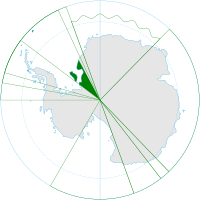Brazilian Antarctica
|
Brazilian Antarctica Antártida Brasileira (Portuguese) |
||
|---|---|---|
| Zone of Interest | ||
|
||
 Coordinates: |
||
| - Designated | 1986 | |
| Population | ||
| • Summer | 100 | |
| • Winter | 48 | |
| Area - Summer - Winter |
— — |
|
| Website | ProAntar | |
Brazilian Antarctica (Portuguese: Antártida Brasileira or Antártica Brasileira) is the name of the Antarctic territory south of 60°S, and from 28°W to 53°W, proposed as "Zone of Interest" by geopolitical scholar Therezinha de Castro. While the substance of that designation has never been precisely defined, it does not formally contradict the Argentine and British claims geographically overlapping with that zone. The country formally expressed its reservations with respect to its territorial rights in Antarctica when it acceded to the Antarctic Treaty on 16 May 1975, making the first official mention of the Frontage Theory, which states (simplified) that sovereignty over each point in Antarctica properly belongs to the first country whose non-Antarctic territory one would reach when travelling north in a straight line from such a point. The Frontage Theory (Teoria da Defrontação) was proposed by Brazilian geopolitical scholar Therezinha de Castro and published in her book Antártica: Teoria da Defrontação.
Outside the zone of interest, Brazil maintains a permanent staffed research facility, the Comandante Ferraz Brazilian Antarctic Base (UN/LOCODE: AQ-CFZ), located in Admiralty Bay, King George Island, near the tip of the Antarctic Peninsula, at 62°08′S 58°40′W / 62.133°S 58.667°W.
...
Wikipedia

